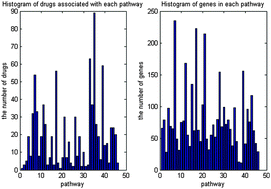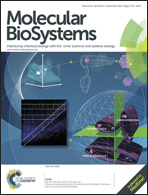Drug–pathway interaction prediction via multiple feature fusion†
Abstract
Predicting new drug–pathway interactions from heterogeneous biological data is important not only for the understanding of various drug response and molecular interaction processes, but also for the development of novel drugs and the therapy of human diseases. In this paper, three different learning methods including the Bipartite Local Models method (BLM), Gaussian Interaction Profiles kernels (GIP) method and Graph-based Semi-supervised Learning method (GBSSL) were used to predict drug–pathway interactions. To realize the purpose, drugs were firstly represented by functional groups and chemical structure similarity, and pathways were represented by their related gene expressions and semantic similarity based features. Then, the parameter optimization procedures were further adopted to deal with heterogeneous data sources. As a result, the proposed methods achieved a high ROC curve score (AUC score) over 0.95, which validated the effectiveness of multiple information integration. Moreover, several new potential drug–pathway interactions were identified for further biological function research.


 Please wait while we load your content...
Please wait while we load your content...